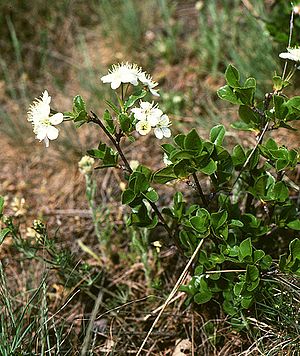Dwarf cherry
| Dwarf cherry | ||||||||||||
|---|---|---|---|---|---|---|---|---|---|---|---|---|

Dwarf cherry ( Prunus fruticosa ) in Lower Austria |
||||||||||||
| Systematics | ||||||||||||
|
||||||||||||
| Scientific name | ||||||||||||
| Prunus fruticosa | ||||||||||||
| Pall. |
The dwarf cherry ( Prunus fruticosa ), also called steppe cherry or dwarf sour cherry , is a species of the rose family (Rosaceae). This shrub bears edible red fruits about 1 centimeter in size.
description
The dwarf cherry is a deciduous, sparsely branched and runners-forming shrub without thorns, which reaches heights of 0.2 to 1 meter, in rare cases up to 1.5 meters. The branches are thin and bare. The leaves have an obovate to elliptical, hardly pointed blade with a notched or serrate edge. They grow to be 2 to 5 inches long and have a shiny, dark green top and a lighter, bare underside. The petiole reaches a length of 0.5 to 1.2 centimeters.
The white flowers are about 1.5 centimeters wide, stalked long and two to five are arranged in sessile, crowded umbels . The sepals are broad and blunt, the petals are slightly edged. The flowering period lasts from April to May.
The stone fruits are spherical and up to 1 centimeter in size. They ripen in June and are then coral-red, more rarely black-red. The fully ripe fruits are edible and a popular wild fruit.
The number of chromosomes is 2n = 32.
Distribution and location requirements
The distribution area of the dwarf cherry extends over Central and Eastern Europe from the southern Rhine Valley and the Apennine Peninsula over the eastern edge of the Alps to Thuringia , the Caucasus and Western Siberia and Central Asia. They are mostly found on calcareous soils in dry bushes, on dry slopes, along paths and in ravines and abandoned quarries. It loves warmth, is usually frost hardy and prefers sunny to light-shaded locations. The dwarf cherry is a characteristic species of the Prunetum fruticosae in Central Europe.
Systematics
The dwarf cherry belongs to another with the sour cherry ( Prunus cerasus ) and bird cherry ( Prunus avium ) to the section Cerasus the subgenus Cerasus which the genus of Prunus is counted. A synonym of Prunus cerasus is Cerasus fruticosa .
use
The dwarf cherry is rarely used as an ornamental plant because of its decorative flowers and fruits; it also donates pollen and nectar for bees.
proof
literature
- Andreas Roloff , Andreas Bärtels: Flora of the woods. Purpose, properties and use. With a winter key from Bernd Schulz. 3rd, corrected edition. Eugen Ulmer, Stuttgart (Hohenheim) 2008, ISBN 978-3-8001-5614-6 , pp. 476-477.
- Bruno P. Kremer: Shrub trees . Recognize & determine. In: Steinbach's nature guide . Mosaik, Niedernhausen 2002, ISBN 3-576-11478-5 , p. 70 .
- Schütt, Schuck, Stimm: Lexicon of tree and shrub species . Nikol, Hamburg 2002, ISBN 3-933203-53-8 , pp. 409 .
Individual evidence
- ↑ a b c d Schütt et al .: Lexicon of tree and shrub species
- ↑ a b Kremer: Shrub trees
- ↑ a b c Roloff et al .: Flora of the Woods
- ↑ a b Erich Oberdorfer : Plant-sociological excursion flora for Germany and neighboring areas . 8th edition. Verlag Eugen Ulmer, Stuttgart 2001, ISBN 3-8001-3131-5 . Page 574.
- ↑ Prunus fruticosa. In: GRIN. Germplasm Resources Information Network (GRIN), accessed April 17, 2010 .





